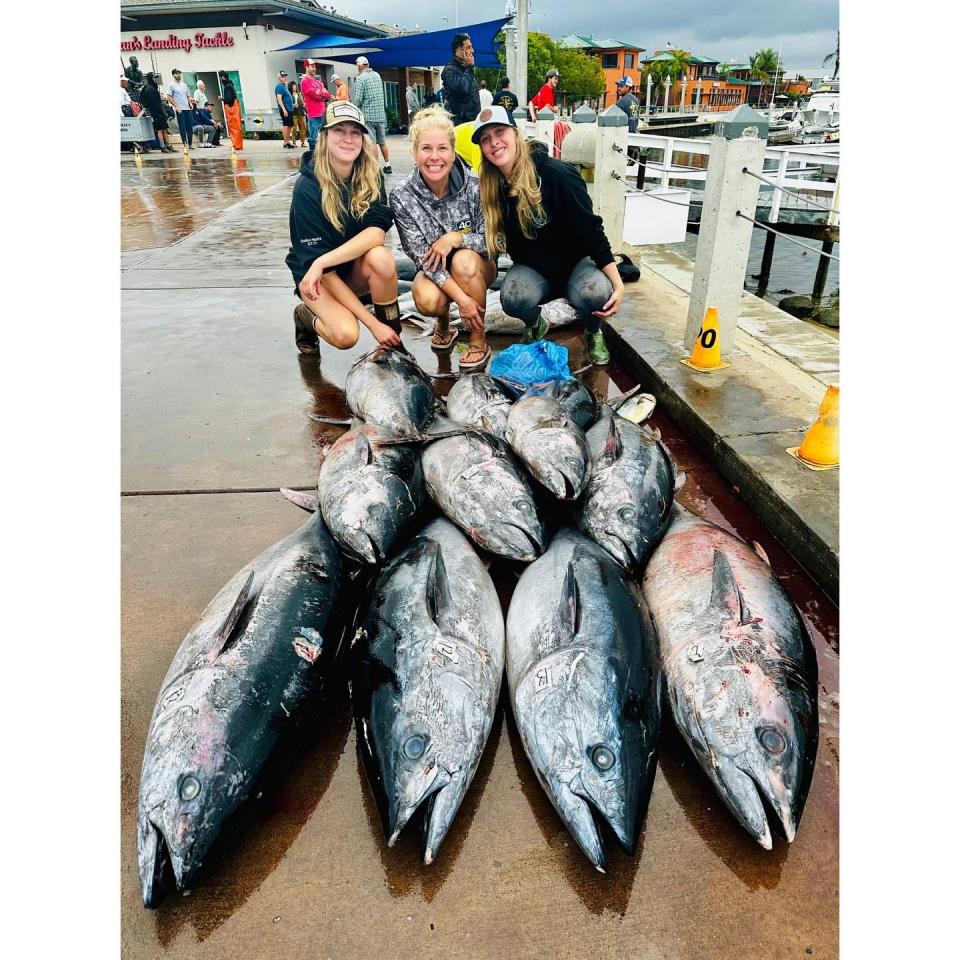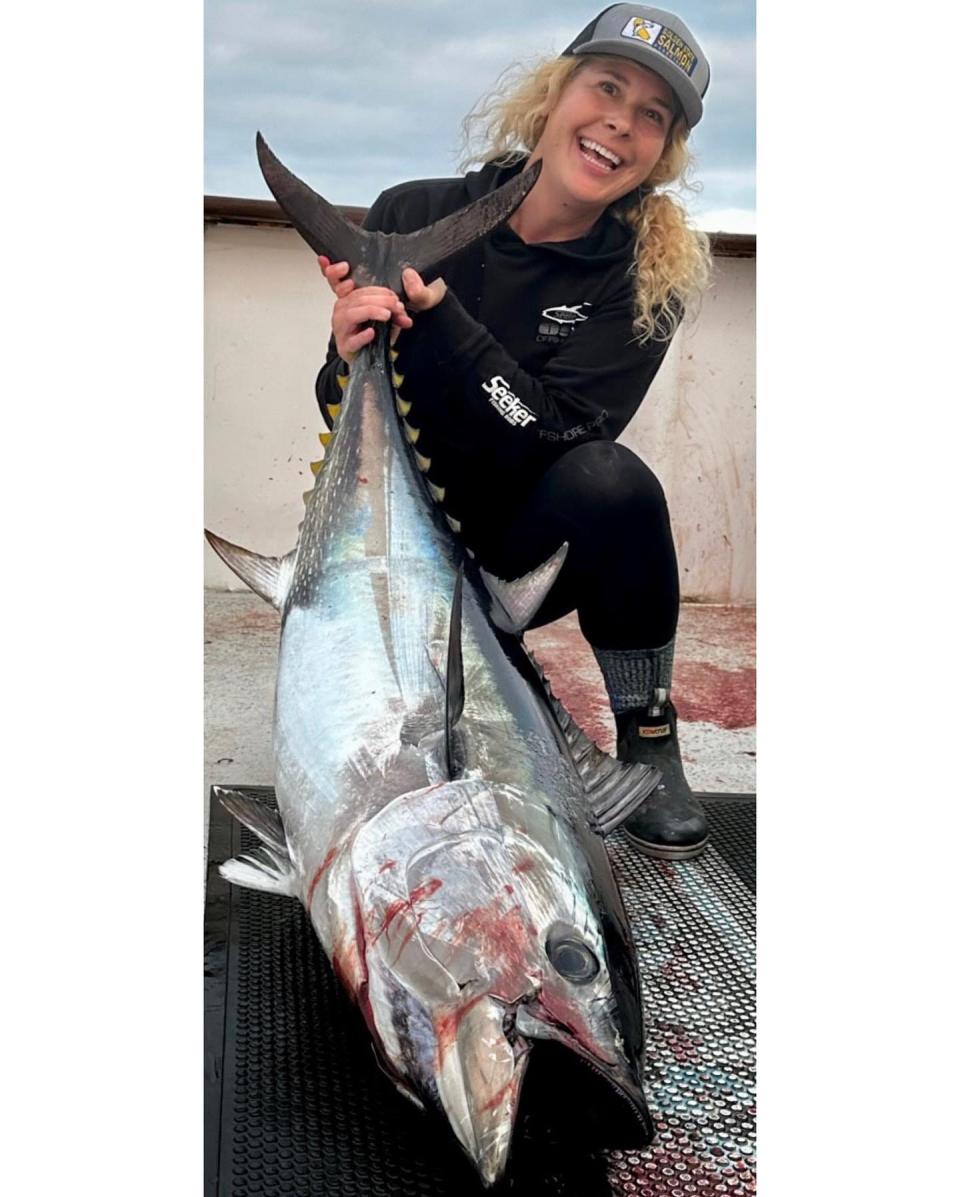Three Fishing Gals Battle Big Offshore Bluefin Tuna
The Pacific bluefin tuna is one of the most elusive fish found in waters off the California coast.
These pelagic (open water) migrants are known for providing one of the hardest, most grueling fights of any fish in our offshore waters, with the largest fish often being fought by teams of two or three anglers.
But three fishing gals — Cat Kaiser, operation and events director for the Golden State Salmon Association (GSSA), Annie Nagel of Rohnert Park and Jessy Ryan of Novato — managed to do something virtually unheard of.

They teamed up to catch their four fish limits of tuna and three fish for the boat, a total of 15 fish, on a 2-1/2 day trip off San Diego. And they caught those fish with both light and heavy fishing gear.
After returning from a trip to San Clemente Island aboard the 90-foot Condor, under the helm of Scott Meisel, owner and captain, and night captain Clint Dunn, Kaiser was ecstatic about the trip.
“Three bruised, blistered, bloody, and sore gals caught 15 bluefin of the perfect kick-your-butt size,“ said Kaiser. “We caught boat limits and were treated to the best bluefin fishing I’ve ever experienced.”
The trip started when Kaiser, Nagel and Ryan flew down from Santa Rosa to Fisherman’s Landing in San Diego. They boarded the Condor on Friday evening, Sept. 16, and left at 7 p.m. The 28 anglers were woken up after sleeping a few hours at 1:30 a.m. to start fishing with Katy Perry pink and blue knife jigs.
“Annie hooked up the first fish of the night on her knife jig and then five minutes later I hooked one,” stated Kaiser. “When you hook one, it first feels like you’ve hit bottom and everything stops. As you catch up with the fish, you start cranking on your reel and the fish smacks you into the rail.”
“We probably spent 20 minutes each going under, over and around others’ lines before the deckhands gaffed the fish. And we fought these fish by ourselves. Fifteen minutes later, Jessie also hooked up on a big tuna. We caught three of the first eight fish on the boat,” she said.
The fish were all quality tuna weighing 70 to 75 pounds each. The piscatorial trio was using Seeker tuna rods and Penn reels filled with 100 lb. test line.
The next day, the three anglers and others continued catching tuna as deckhands Miguel, John, Aiden and Justin, helped out by Greg, the cook, gaffed one fish after another. These fish averaged around 65 pounds each.
Kaiser, Nagel and Ryan switched to lighter gear — 7 to 8-foot rods with 25 lb. test line on their reels — and the fish took longer to bring in, anywhere from 30 to 45 minutes.
“The three girls caught 8 more tuna during (the) day using the light gear,” she said. “All of the guys said we were beasts — it was unbelievable fishing.”
“On the second night of fishing jigs, I hooked up the first fish. I landed it pretty quickly, then dropped down again. And then I hooked up another fish right away. I landed two 85 lb. fish back-to-back,” Kaiser stated.
“The next day we woke up and didn’t know if we should fish because we were sore and beat up, with bleeding thumbs. But we ended up fishing again. We needed 12 more fish to reach two-day boat limits. Jessie and Annie each caught one while fly-lining live sardines,” she said.
The 28 anglers on the boat landed their limits by 1 p.m. and then the captain looked around for dorado and yellowtail. Anglers aboard the boat landed five dorado, but they didn’t get anything after that.
“It was honestly the top bluefin tuna fishing I have ever experienced. I was so grateful to go fishing with two amazing gals. All three of us supported each other and made sure we took videos of each other. There was no drama. It was all laughs and good times,” she emphasized.
“Since the trip, we have been cracking up, sharing our stories with each other and reminiscing about the trip. With the three of us, friendship is first. When you add great weather, great fishing, great food and a great crew, you have the recipe for an epic trip,” Kaiser stated.
Kaiser noted that the biggest fish caught on the boat weighed 120 pounds, while the fish in her limit ranged from 75 to 85 pounds.
After the trip was over, the three anglers dropped off 720 pounds of tuna to be filleted and bagged by a processor, after they had one tuna filleted aboard the boat and the three other fish given away. “We are planning to have a sushi party with some of the fish we caught,” she added.

“These fish were all the perfect size — kick your ass, but manageable on your own,” she emphasized. “The captain and crew are the most helpful and hardworking of any tuna boat that I have been on.”
“And everybody on the boat was so nice to us; one guy asked us if he could take a photo so he could show his wife how three gals kicked butt while tuna fishing. It was a trip of a lifetime celebrating my birthday,” Kaiser concluded.
Anglers catch bluefin tuna year-round, but most Pacific bluefin tuna are caught between May and October, according to NOAA Fisheries. Most of the catch of bluefin tuna is within about 100 miles of the California Coast. While Southern California offshore waters produce the most consistent bluefin tuna fishing, anglers also are targeting bluefin tuna in Northern and Central California waters.
“Like many other pelagic (open water species), bluefin tuna populations have declined in populations in recent years. Although Pacific-wide populations are well below target levels, U.S. wild-caught Pacific bluefin tuna is a smart seafood choice because it is sustainably managed under rebuilding measures that limit harvest by U.S. fishermen,” NOAA Fisheries reported on their website.
The maximum reported length and weight for Pacific bluefin tuna is 9.8 feet in length and 990 pounds.
This article originally appeared on Visalia Times-Delta: Three Fishing Gals Battle Big Offshore Bluefin Tuna

